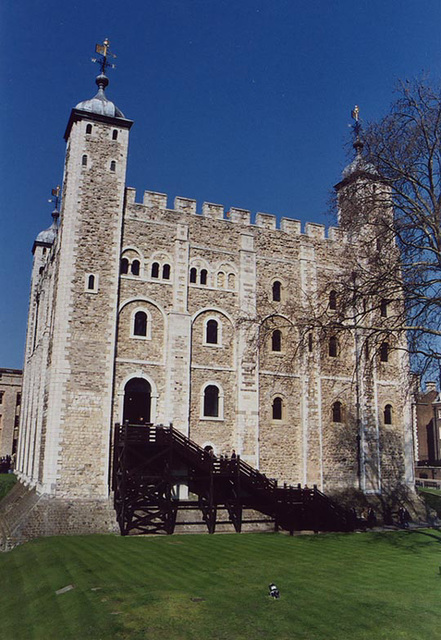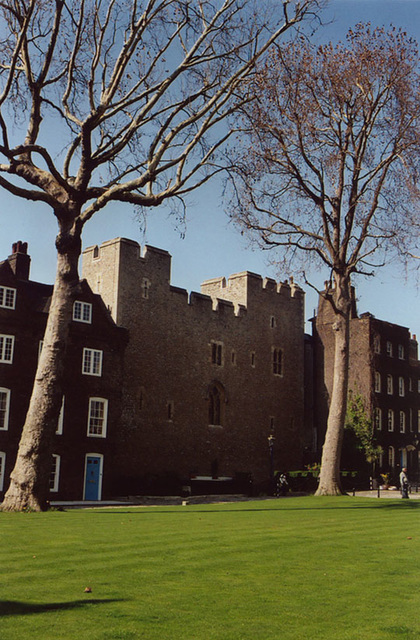
Tower of London, March 2004
Her Majesty's Royal Palace and Fortress The Tower of London, more commonly known as the Tower of London (and historically simply as The Tower), is an historic monument in central London, England on the north bank of the River Thames. It is located within the London Borough of Tower Hamlets and is separated from the eastern edge of the City of London by the open space known as Tower Hill.
The To… (read more)
The To… (read more)
The White Tower, March 2004
The White Tower is the oldest of the "towers" at the Tower of London, built under William the Conqueror. Photo taken in March, 2004.
The White Tower, March 2004
The White Tower is the oldest of the "towers" at the Tower of London, built under William the Conqueror. Photo taken in March, 2004.
The White Tower, March 2004
The White Tower is the oldest of the "towers" at the Tower of London, built under William the Conqueror. Photo taken in March, 2004.
Caution: Ravens Bite, 2004
Legend says if the ravens ever leave the Tower of London, the kindom will fall. The English have prevented this from happening by clipping the wings of the ravens that they keep at the Tower. This is a view of their cage. On my first trip to London in 1997, there was a sign, near the area of the scaffold, which read, "Caution: ravens bite!"
The Queen's House in the Tower of London, 2004
The Queen's House
The Queens House was built about 1530, probably for Queen Anne Boleyn, but she lived there only as a prisoner for 18 days awaiting her execution. The second queen of Henry VIII and mother of Elizabeth I, she was beheaded on Tower Green by a French executioner for alleged infidelity; it is said she felt the French more skilled at the task of beheading. As a princess interned at the Bell Tower, Elizabeth I was permitted to dine here. Despite the presence of these and future Queens, the building was known until 1880 as the Lieutenant's Lodgings.
It is a very fine example of half timbered Tudor architecture. Within a few years of completion, a floor was inserted at second storey level in the lofty hall making what is known as the Council Chamber. The chamber has a magnificent 16 century rafted ceiling and contains an elaborate tablet commemorating the Gunpowder Plot erected in 1608 by the then Governor, Sir William Waad. In this room Guy Fawkes was interrogated and after torture on the rack in the White Tower, signed a confession incriminating his fellow conspirators.
Adjoining the Council Chamber is a room in which William Penn, the famous Quaker who founded the state of Pennsylvania, was once a prisoner. And in modern times the notorious Rudolph Hess, Nazi leader and German deserter during World War II, was imprisoned here.
Text from: www.toweroflondontour.com/queensh.html
The Beauchamp Tower, 2004
The Beauchamp Tower
Henry III and his son, Edward I, are to be attributed to the creation of the Beauchamp Tower. Henry III is responsible for many of the towers and structures in the Tower of London, with eight wall towers built during the latter part of his reign. It was during Edward's reconstruction of the western section that he replaced a twin-towered gatehouse built by Henry with the Beauchamp Tower around 1275-81.
Architecturally, the large amount of brick used, as opposed to solely that of stone, was innovative at its time for castle construction. The tower takes its name from Thomas Beauchamp, Earl of Warwick, imprisoned 1397-99 by Richard II. The three-storey structure was used often for prisoners of high rank.
Of special interest are the inscriptions carved on the stone walls here by prisoners. The most elaborate is a memorial to the five brothers Dudley, one of whom was Lord Guildford Dudley, husband of Lady Jane Grey. This unhappy pair were executed in 1554
Text from: www.toweroflondontour.com/beauchmp.html
The Beauchamp Tower, 2004
The Beauchamp Tower
Henry III and his son, Edward I, are to be attributed to the creation of the Beauchamp Tower. Henry III is responsible for many of the towers and structures in the Tower of London, with eight wall towers built during the latter part of his reign. It was during Edward's reconstruction of the western section that he replaced a twin-towered gatehouse built by Henry with the Beauchamp Tower around 1275-81.
Architecturally, the large amount of brick used, as opposed to solely that of stone, was innovative at its time for castle construction. The tower takes its name from Thomas Beauchamp, Earl of Warwick, imprisoned 1397-99 by Richard II. The three-storey structure was used often for prisoners of high rank.
Of special interest are the inscriptions carved on the stone walls here by prisoners. The most elaborate is a memorial to the five brothers Dudley, one of whom was Lord Guildford Dudley, husband of Lady Jane Grey. This unhappy pair were executed in 1554
Text from: www.toweroflondontour.com/beauchmp.html
01 Mar 2004
Window Inside the Beauchamp Tower, 2004
The Beauchamp Tower
Henry III and his son, Edward I, are to be attributed to the creation of the Beauchamp Tower. Henry III is responsible for many of the towers and structures in the Tower of London, with eight wall towers built during the latter part of his reign. It was during Edward's reconstruction of the western section that he replaced a twin-towered gatehouse built by Henry with the Beauchamp Tower around 1275-81.
Architecturally, the large amount of brick used, as opposed to solely that of stone, was innovative at its time for castle construction. The tower takes its name from Thomas Beauchamp, Earl of Warwick, imprisoned 1397-99 by Richard II. The three-storey structure was used often for prisoners of high rank.
Of special interest are the inscriptions carved on the stone walls here by prisoners. The most elaborate is a memorial to the five brothers Dudley, one of whom was Lord Guildford Dudley, husband of Lady Jane Grey. This unhappy pair were executed in 1554
Text from: www.toweroflondontour.com/beauchmp.html
Jump to top
RSS feed- Latest items - Subscribe to the latest items added to this album
- ipernity © 2007-2024
- Help & Contact
|
Club news
|
About ipernity
|
History |
ipernity Club & Prices |
Guide of good conduct
Donate | Group guidelines | Privacy policy | Terms of use | Statutes | In memoria -
Facebook
Twitter










